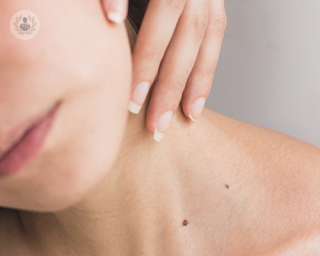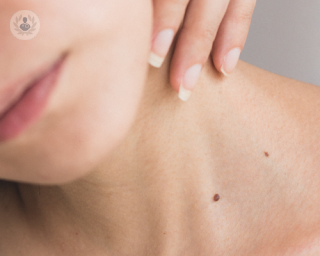What are skin tags, and how harmful are they?
Skin tags are small benign growths that can hang from your skin. They are relatively common and are not harmful. However, some people with skin tags prefer to have them removed if they do not like their appearance, or if they are located in a place that causes irritation (e.g. near bra straps, or on the neck close to jewellery).
How are skin tags typically removed?
Skin tag removal involves either freezing or burning them off, or removing them surgically.

What do skin tags consist of?
Skin tags are generally made up of a mixture of fat, collagen fibers, tiny blood vessels, and nerve cells.
What causes the appearance of skin tags?
If you begin to develop an abnormally high number of skin tags, this may be due to a hormonal imbalance or an early sign of pre-diabetes or frank diabetes.
Where on the body are skin tags most commonly found?
Skin tags most typically appear on the neck, the armpits, around the eyes, and beneath the breasts.
Who is most at risk from getting skin tags?
Although not proven, various studies have demonstrated that people who suffer from diabetes, who are overweight, and/or who are pregnant, are at a higher risk of getting skin tags on some area(s) of their skin.
What are the most common/most popular skin tag removal options, and how are they performed?
As mentioned above, skin tags are not harmful, and thus, need not be removed. However, if one's skin becomes irritated, there are various different options available for patients who wish to have them removed.
One such option is cryotherapy. Cryotherapy consists of a dermatologist freezing off the skin tag via the use of liquid nitrogen, which is a highly effective way of removing skin tags.
Other skin tag removal options include shave excision, snipping, and electrocautery. where an electric probe or needle is used to burn off the skin tag.
What does skin tag removal surgery consist of?
Skin tag removal surgery is an outpatient procedure. If surgical excision is required, your dermatologist will numb the area of skin where the skin tag is located with a local anaesthetic. Once the area is numb, your dermatologist will then carefully remove the skin tag.
Which specialist treats skin tags?
Typically, dermatologists are the medical specialists who are responsible for treating skin tags and performing skin tag removal surgery.

Is it safe to remove my skin tag at home?
It is recommended that patients avoid trying to remove their skin tags themselves at home to avoid infection, and for larger skin tags, excessive bleeding and scarring. A dermatologist is highly skilled when it comes to removing skin tags for patients.
Are skin tags an early warning sign of skin cancer?
Thankfully, the development of skin tags are not deemed to be an early warning sign of skin cancer. However, there are skin cancers that can look like a skin tag and if you are not sure, it is best to visit your dermatologist for a skin biopsy.
Are they contagious?
No, skin tags cannot be passed from one individual to another.
How big can skin tags become?
It is thought that skin tags can grow up to five centimetres in diameter.
How will I know if they are skin tags?
The appearance of a skin tag will typically be brown or flesh colour. They are bump-like pieces of irritated skin, and they can either be smooth or wrinkled in texture.
09-22-2020 07-13-2023Skin tag removal
Dr Marisa Taylor - Dermatology
Created on: 09-22-2020
Updated on: 07-13-2023
Edited by: Carlota Pano
What are skin tags, and how harmful are they?
Skin tags are small benign growths that can hang from your skin. They are relatively common and are not harmful. However, some people with skin tags prefer to have them removed if they do not like their appearance, or if they are located in a place that causes irritation (e.g. near bra straps, or on the neck close to jewellery).
How are skin tags typically removed?
Skin tag removal involves either freezing or burning them off, or removing them surgically.

What do skin tags consist of?
Skin tags are generally made up of a mixture of fat, collagen fibers, tiny blood vessels, and nerve cells.
What causes the appearance of skin tags?
If you begin to develop an abnormally high number of skin tags, this may be due to a hormonal imbalance or an early sign of pre-diabetes or frank diabetes.
Where on the body are skin tags most commonly found?
Skin tags most typically appear on the neck, the armpits, around the eyes, and beneath the breasts.
Who is most at risk from getting skin tags?
Although not proven, various studies have demonstrated that people who suffer from diabetes, who are overweight, and/or who are pregnant, are at a higher risk of getting skin tags on some area(s) of their skin.
What are the most common/most popular skin tag removal options, and how are they performed?
As mentioned above, skin tags are not harmful, and thus, need not be removed. However, if one's skin becomes irritated, there are various different options available for patients who wish to have them removed.
One such option is cryotherapy. Cryotherapy consists of a dermatologist freezing off the skin tag via the use of liquid nitrogen, which is a highly effective way of removing skin tags.
Other skin tag removal options include shave excision, snipping, and electrocautery. where an electric probe or needle is used to burn off the skin tag.
What does skin tag removal surgery consist of?
Skin tag removal surgery is an outpatient procedure. If surgical excision is required, your dermatologist will numb the area of skin where the skin tag is located with a local anaesthetic. Once the area is numb, your dermatologist will then carefully remove the skin tag.
Which specialist treats skin tags?
Typically, dermatologists are the medical specialists who are responsible for treating skin tags and performing skin tag removal surgery.

Is it safe to remove my skin tag at home?
It is recommended that patients avoid trying to remove their skin tags themselves at home to avoid infection, and for larger skin tags, excessive bleeding and scarring. A dermatologist is highly skilled when it comes to removing skin tags for patients.
Are skin tags an early warning sign of skin cancer?
Thankfully, the development of skin tags are not deemed to be an early warning sign of skin cancer. However, there are skin cancers that can look like a skin tag and if you are not sure, it is best to visit your dermatologist for a skin biopsy.
Are they contagious?
No, skin tags cannot be passed from one individual to another.
How big can skin tags become?
It is thought that skin tags can grow up to five centimetres in diameter.
How will I know if they are skin tags?
The appearance of a skin tag will typically be brown or flesh colour. They are bump-like pieces of irritated skin, and they can either be smooth or wrinkled in texture.


Safe skin tag removal, according to a GP
By Dr Amar Lally
2024-11-21
Skin tags are growths that are often mistaken for warts or pigmented moles. Here to provide an expert insight into skin tags, including risk factors and removal options, is Dr Amar Lally, highly experienced general practitioner with a specialist interest in dermatology. See more


Skin tag removal: What to expect
By Dr Andrew Burgess
2024-11-20
Considering getting a skin tag removed? Do you have questions about this minor operation? Leading private GP Dr Andrew Burgess can help. He goes into expert detail into the skin tag removal procedure in this informative article. See more


What are skin tags and how do I get rid of them?
By Mr Niall Kirkpatrick
2024-11-20
Skin tags are harmless, usually painless, small, soft, skin-coloured growths. They are mainly just a few millimetres in size, although they can grow bigger and tend to look like elongated growths that hang off the skin. They are made of loose collagen fibres, small blood vessels and skin. Although harmless and not contagious, people often dislike the appearance of skin tags. Here to tell us more about skin tags and how to get rid of them is plastic surgeon Mr Niall Kirkpatrick. See more


What are anal skin tags?
By Mr Rajeev Peravali
2024-11-19
Anal skin tags are small, benign (non-cancerous) growths that develop around the anus. They are typically soft and flesh-coloured, often described as resembling small flaps or bumps of skin. Though they are harmless, anal skin tags can sometimes cause discomfort or concern, especially if they become irritated. These skin tags are quite common and may affect people of any age or gender. We speak to specialist colorectal surgeon Mr Rajeev Peravali who explains what they are and how they are diagnosed.. See more
Experts in Skin tag removal
-
Dr Christopher Heaton
DermatologyExpert in:
- Skin cancer
- Moles
- Skin tag removal
- Rash
- Pruritus (itchy skin)
- Acne
-
Dr Sabina Ghani
DermatologyExpert in:
- Cosmetic dermatology
- Skin allergies
- Eczema
- Acne
- Skin infections
- Skin tag removal
-
Dr Andrew Burgess
GP (general practitioner)Expert in:
- Joint injections
- Skin tag removal
- Blood test
- Musculoskeletal pain
- Men's health check
- Chronic diseases
-
Dr Lathika Wickramasinghe
DermatologyExpert in:
- Skin cancer
- Moles
- Skin tag removal
- Genital warts
- Warts
- Cryotherapy
-
Dr Andrzej Rozanski
DermatologyExpert in:
- Cryosurgery
- Psoriasis
- Eczema
- Moles
- Skin diseases
- Skin tag removal
- See all

The London Dermatology Centre
The London Dermatology Centre
69 Wimpole Street, London,
No existe teléfono en el centro.
By using the telephone number provided by TOP DOCTORS, you automatically agree to let us use your phone number for statistical and commercial purposes. For further information, read our Privacy Policy
Top Doctors

Fitzrovia Medical Clinic
Fitzrovia Medical Clinic
Fitzrovia Hospital, 13-14 Fitzroy Square
No existe teléfono en el centro.
By using the telephone number provided by TOP DOCTORS, you automatically agree to let us use your phone number for statistical and commercial purposes. For further information, read our Privacy Policy
Top Doctors

New Victoria Hospital
New Victoria Hospital
184 Coombe Lane West, Kingston upon Thames, KT2 7EG
No existe teléfono en el centro.
By using the telephone number provided by TOP DOCTORS, you automatically agree to let us use your phone number for statistical and commercial purposes. For further information, read our Privacy Policy
Top Doctors
-
The London Dermatology Centre
69 Wimpole Street, London, , W1G Marylebone LondonExpert in:
- Skin Cancer
- Dermatology
- Clinical Dermatology
- Cosmetic Dermatology
- Surgical Dermatology
-
Fitzrovia Medical Clinic
Fitzrovia Hospital, 13-14 Fitzroy Square , Central LondonExpert in:
- Adult Diabetes
- Chronic diseases
- Women’s health
- Paediatrics
- Health check up
- Sexual health
-
New Victoria Hospital
184 Coombe Lane West, Kingston upon Thames, KT2 7EG, South LondonExpert in:
- Cardiology
- General Surgery
- Orthopaedic surgery
- Breast augmentation
- Pain management
- Spine
- Most viewed diseases, medical tests, and treatments
- Migraine
- Autoimmune diseases
- Joint pain
- Nutrition
- Weight loss injections
- Endermologie
- Polynucleotides
- Head and neck cancer
- Neck lump
- Bariatric surgery








